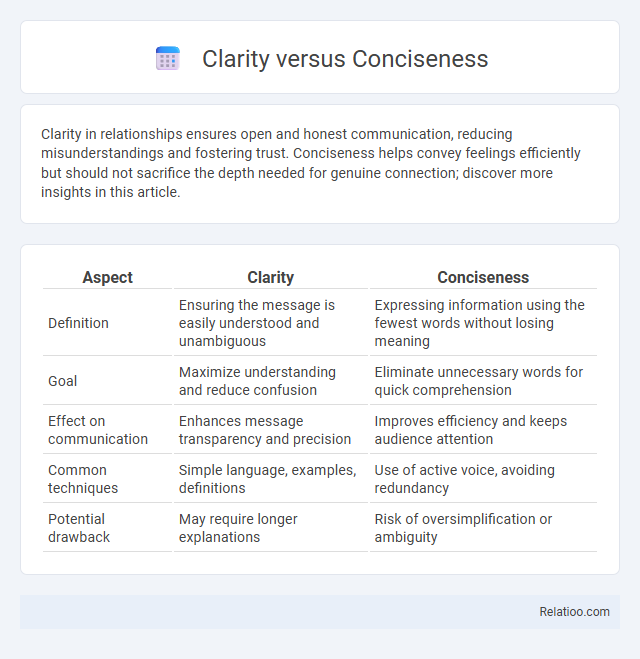Clarity in relationships ensures open and honest communication, reducing misunderstandings and fostering trust. Conciseness helps convey feelings efficiently but should not sacrifice the depth needed for genuine connection; discover more insights in this article.
Table of Comparison
| Aspect | Clarity | Conciseness |
|---|---|---|
| Definition | Ensuring the message is easily understood and unambiguous | Expressing information using the fewest words without losing meaning |
| Goal | Maximize understanding and reduce confusion | Eliminate unnecessary words for quick comprehension |
| Effect on communication | Enhances message transparency and precision | Improves efficiency and keeps audience attention |
| Common techniques | Simple language, examples, definitions | Use of active voice, avoiding redundancy |
| Potential drawback | May require longer explanations | Risk of oversimplification or ambiguity |
Understanding Clarity in Communication
Clarity in communication ensures your message is easily understood by eliminating ambiguity and using precise language. It enhances comprehension by organizing information logically and emphasizing key points, making it straightforward for your audience to grasp the intended meaning. Prioritizing clarity over conciseness prevents misunderstandings and supports effective information exchange in all interactions.
The Essence of Conciseness
Conciseness emphasizes delivering essential information using the fewest effective words, which enhances clarity by removing unnecessary details that can distract the reader. Achieving the essence of conciseness involves prioritizing relevant content and structuring sentences to convey precise meaning efficiently. Clear communication balances brevity with sufficient context, ensuring that concise expressions do not sacrifice understanding.
Why Clarity Matters More Than Brevity
Clarity matters more than brevity because clear communication ensures the audience fully understands the message without ambiguity or confusion, which is essential for effective decision-making and collaboration. While conciseness helps eliminate unnecessary words, sacrificing clarity can lead to misunderstandings, misinterpretations, and errors, especially in complex fields like law, medicine, and engineering. Prioritizing clarity enhances knowledge retention and trust, making it the cornerstone of impactful and reliable communication.
The Dangers of Over-Conciseness
Over-conciseness can undermine clarity by omitting essential details that help You fully understand the message, leading to confusion or misinterpretation. Striking a balance between clarity and conciseness ensures that communication is both efficient and effective, preserving important context without overwhelming the reader. Prioritizing only brevity risks critical information loss, negatively impacting decision-making and comprehension.
Common Misconceptions About Being Concise
Common misconceptions about being concise include the belief that brevity equals clarity or that cutting words always improves understanding. True conciseness requires selecting precise language while maintaining clear communication to avoid ambiguity. Striking a balance between clarity and conciseness ensures messages are both straightforward and complete, preventing oversimplification that can confuse readers.
How to Achieve Clarity Without Wordiness
Achieving clarity without wordiness requires precise language that conveys your message directly and avoids unnecessary filler. Focus on choosing specific, meaningful words that eliminate ambiguity, ensuring your audience easily understands your point. You can enhance readability by breaking complex ideas into simple, digestible phrases that maintain your message's strength without over-explaining.
Key Strategies for Balancing Clarity and Conciseness
Balancing clarity and conciseness requires prioritizing key information while eliminating redundant words that obscure your message. Employing precise language and active voice enhances understanding without unnecessary elaboration. You can achieve effective communication by organizing content logically and using clear formatting to guide readers swiftly through essential points.
Real-World Examples: Clarity vs Conciseness
Clarity ensures your message is easily understood, while conciseness keeps it brief and to the point, preventing information overload. For instance, in technical manuals, clarity helps users follow complex instructions, whereas conciseness enables quick reference without unnecessary detail. You must balance these elements to maintain effective communication, ensuring your audience grasps key information without confusion or excessive wording.
Tools and Techniques to Enhance Writing Precision
Tools like Grammarly, Hemingway Editor, and ProWritingAid offer real-time feedback to improve clarity and conciseness by suggesting simpler words and removing redundant phrases. Techniques such as active voice, precise vocabulary, and sentence variety enhance writing precision by making content more engaging and easier to understand. Utilizing style guides like the APA or Chicago Manual of Style ensures consistent clarity and conciseness across different writing contexts.
Final Thoughts: Striking the Perfect Balance
Striking the perfect balance between clarity and conciseness enhances your communication by ensuring messages are easily understood without unnecessary words. Prioritize clarity to avoid ambiguity while maintaining conciseness to keep content engaging and efficient. Mastering this balance improves reader comprehension and retention, making your writing more impactful.

Infographic: Clarity vs Conciseness
 relatioo.com
relatioo.com